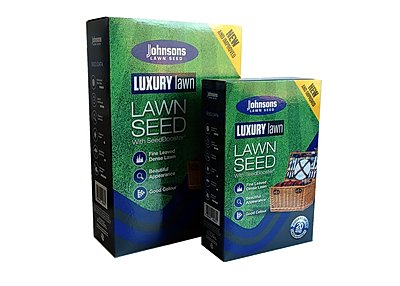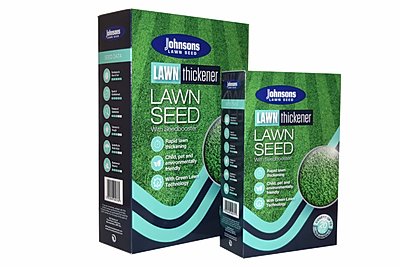Autumn is the perfect season for sowing or overseeding lawns, says Johnsons Lawn Seed
Published:
Read Time: 4 mins
After a long summer of wear and tear, there is no better time for breathing new life into tired turf, or for sowing a brand new lawn, than autumn.
Throughout September and until mid-October, the soil remains warm and workable but temperatures are refreshingly cooler, allowing grass seed to germinate quickly and establish before winter sets in. Crucially, the weakening sun results in less moisture being lost to evaporation, so gardeners can get new lawns up and growing fast.
Johnsons Lawn Seed’s Guy Jenkins said: “As the nights draw in and schools go back, it’s the perfect time to give your lawn a little TLC – a bit of work in autumn will pay dividends. Not only will it result in a stronger and more robust lawn that’s better placed to withstand the ravages of winter, but it will stand turf in good stead for next season, giving gardeners a lawn to be proud of next summer.”
The prospect of autumn lawncare needn’t be daunting, even for new or inexperienced gardeners. Johnsons Lawn Seed has put together a five-point action plan to help gardeners transform their turf before temperatures plunge and grass stops growing.
1 Scarify your lawn
Look down after mowing and you’ll probably discover lots of thatch – that’s dead moss, old grass stems and debris. Scarifying, the process of pulling out dead material, is vital before overseeding to thicken your lawn. Vigorous raking using a spring-tined rake will take care of small lawns, but for medium or large expanses of turf, a powered scarifier is vital. You’ll be amazed at the amount of thatch these machines pull out, and it can all be easily composted.
2 Aerate compacted areas
We all have areas of lawn that are heavily trodden in summer and can look tatty late in the season – grass close to patios and barbecue areas is a prime example. Aerating is a fancy word for spiking a lawn, allowing air and water to penetrate deep into the rootzone. Small lawns can be deeply spiked with a garden fork every 15cm (6in) apart, but if you garden on clay soil which is prone to waterlogging, use a hollow tine aerator every few years. Holes left by this handy machine should be filled with top-dressing (a mix of loam, sand and organic matter, available at garden centres), which encourages better rooting and thicker turf.
3 Choose your dream lawn
Before overseeding, or sowing a new lawn, consider what your garden is used for – and what type of lawn would suit your needs best. If hard-wearing grass for the kids to play footy on is top priority, choose Tuffgrass from Johnsons Lawn Seed. If your goal is a deluxe lawn that will be your pride and joy, Luxury Lawn will provide a beautiful finish. For lawns cast into shade by trees and buildings, Shady Place lawn seed creates a dense sward, while After Moss is the one to go for where moss is a problem in poorly-drained, low-nutrient soil.
4 Overseed and banish patches
If your lawn is looking sparse, and bare patches are evident after scarifying or removing weeds, unsightly areas can easily be tackled in autumn. To treat patches, use a garden fork to break the surface and rake the soil until it’s fine and even. Sow fast-germinating Lawn Thickener Lawn Seed and lightly rake it into the soil surface, then water gently. You can use Lawn Thickener to overseed the entire lawn, taking care to distribute the seed evenly across the area. There’s no need to worry about seed disappearing, as the clever Seedbooster coating harmlessly deters hungry birds.
5 Sow new lawns
September or October, when it’s neither too hot nor too cold, are perfect months for starting new lawns from scratch. Whichever Johnsons Lawn Seed mix you choose, preparing a good seed bed is the key to success. Remove any debris and apply weedkiller or hand-weed. A couple of weeks later, dig the site over, removing roots of any perennial weeds. Rake the seed bed to a fine tilth, then leave for a fortnight. Once any further weeds have been removed, you can sow, rake-in the seed, gently tread the area over to firm the seed in, then water. In good conditions, grass will start emerging in a week, with the lawn established in six to eight weeks’ time.
Find out more
To find out more about Johnsons Lawn Seed products please visit http://www.johnsonslawnseed.com/product-range.aspx
ENDS
Words: 722
For more information, interviews or images please contact:
Kimberley Hornby Tel: 07851610573 Email: kimberley@hornbywhitefootpr.co.uk
Marc Rosenberg Tel: 07931645170 Email: marc@hornbywhitefootpr.co.uk
Ends
Editors notes
Comprising a uniquely collaborative network of senior PR professionals based at offices around England, Hornby Whitefoot PR has helped a wide range of companies and brands to communicate their news, build business and reposition their reputations since 2015. From strategy to tactics, project management to copy-writing, Hornby Whitefoot PR offers flexible, proactive public relations expertise, founded on real business and marcomms understanding. And our ‘open book’, annual budget or project-based approach – with no murky retainers to hide behind – means you can trust us to make your money go further. Specialisms include the garden, home and lifestyle sector, and the automotive aftermarket industry.




